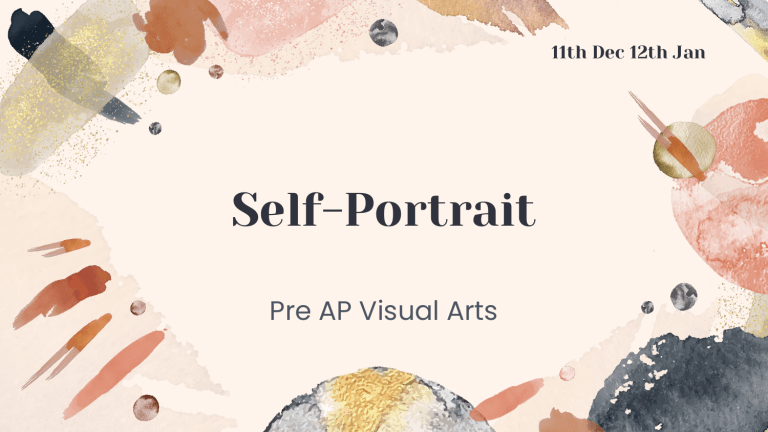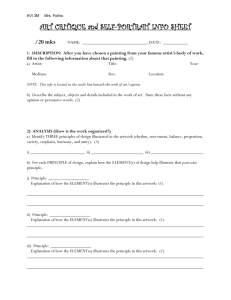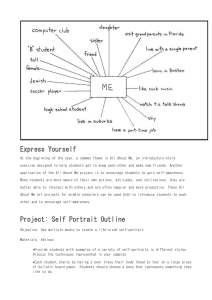
11th Dec 12th Jan Self-Portrait Pre AP Visual Arts Objectives & Ajenda ● ● To understand that there are different media techniques in art. To master the found object art techniques. Lesson 1 Reflection & History Lesson 2 Research Lesson 3-11 Work in progress Lesson 12 Final Submission Warm Up Discussion Topic How is art a form of communication? ANALYSIS AND INTERPRETATION In observing, students are Identifying and describing material, process, and form. ● Material: The substances (digital and physical) that the artist manipulates ● Process: The ways in which the artist plays with ideas and manipulates or applies materials ● Form: The formal elements, compositional arrangement, or format of the artwork In analyzing the work and applying these understandings, students delve into context and content. ● Context: The circumstances that surround the artwork (where, when, how, and for what purpose the work was made), including what was historically present for the artist at the time the artwork was made. As the context of an artwork changes, so too does its meaning. ● Content: The concept, big idea, or subject of the artwork. (Note: The visible subject matter is not necessarily the same as the content. For example, water lilles were often Monet's subject matter, but light was his content.) The interplay of all of these elements defines the meaning of the work. Reflection ● What do you notice about this image? How would you describe it in detail for someone who cannot see it? ● How do you think this work was made? What kind of processes does the artist seem to have used? ● When do you think it was made? Reflection ● ● ● Cindy Sherman 1990 made this photograph Untitled #228 Part of her history portrait series. Responding to reproductions of Italian Renaissance and Baroque paintings. Reflection ● ● ● ● Botticelli’s Judith with the head of Holofernes One of the historical paintings that inspired Sherman’s work. What are some similarities and differences between the two works? Is the photograph more realistic than the painting? Why or why not? Reflection ● ● Instead of copying Botticelli’s painting she has taken inspiration by reimagining it with herself as Judith. In doing so, Sherman appropriated preexisting image through intentional borrowing. What makes a Self-Portrait? ● Cindy Sherman has put herself in this image, but would you call it a self-portrait? Why or why not? ● Given your definition of a self-portrait, is a selfie always a self-portrait? Why or why not? Reflection ● What do you notice about this work? What captures your eye first? ● What do you see that you think someone else might miss? ● What do you notice about this work’s form/material/subject matter/context? Reflection Which aspects are similar and which are different? The Swing painted in France 1767 by Jean-Honoré Fragonard. The installation was created by Yinka Shonibare a British Nigerian artist in 2001 ● Analysis and Application ● ● ● ● ● Why might Shonibare have selected the Fragonard work as the basis of his own work? What might he have been interested in or responding to in the original painting? We just talked about the ways that artists often appropriate elements of one another's work but change parts of the original to transform the way the work is seen. Which aspects of The Swing did Shonibare keep? Which did he alter? What are the effects of these changes? Suggest one adaptation that could be made to the form, materials, subject matter, or context of Shonibare's work. How would your suggested change alter the way a viewer might see and understand the work? Final Project Description: Create a self-Portrait with a specific historical influence. Create a Self-Portrait Painting 1. Start by researching a historical portrait and synthesize your ideas and findings into three sentences worth of information. (WHO, WHAT, WHERE, WHEN, WHY) Example: in 1656, Diego Velazquez painted Las Meninas, depicting the Infanta Margarita and her attendance, for the subject’s parents, the king and the queen of Spain. Description: Final Project Create a self-Portrait with a specific historical influence. Create a Self-Portrait Painting 1. 2. You will then combine it with a self-portrait in the creation of a new work. Use the following Because-but-so sentence to describe which aspects of the work you would like to intentionally borrow. Example: I am interested in using (specific element of the original work) in my portrait because…………….. A REASON I am interested in using (specific element of the original work) in my portrait but…………….. A CHANGE I am interested in using (specific element of the original work) in my portrait so…………….. AN EFFECT Final Project Description: Create a self-Portrait with a specific historical influence. Create a Self-Portrait Painting 1. 2. 3. Share and answer these questions: a. Why did you initially select this work? What makes it intriguing, beautiful or troubling? b. What are the most interesting things that you learned in the research process? Final Project Description: Create a self-Portrait with a specific historical influence. Create a Self-Portrait Painting 1. 2. 3. 4. Based on your chosen art historical portrait, you will create a 2D Self Portrait painting by adapting, rearranging, or eliminating elements of the original artwork. This portrait might showcase your personality or suggest something about who you are or who you would like to become. Final Project Description: Create a self-Portrait with a specific historical influence. Create a Self-Portrait Painting 1. 2. 3. 4. 5. Sketch your ideas in three different drawings in your sketchbook. Answer this question: How are you making this a self-portrait? What does this portrait tell people about who you are? Rubric Rubric Face Face THANKS! CREDITS: This presentation template was created by Slidesgo, and includes icons by Flaticon, and infographics & images by Freepik



